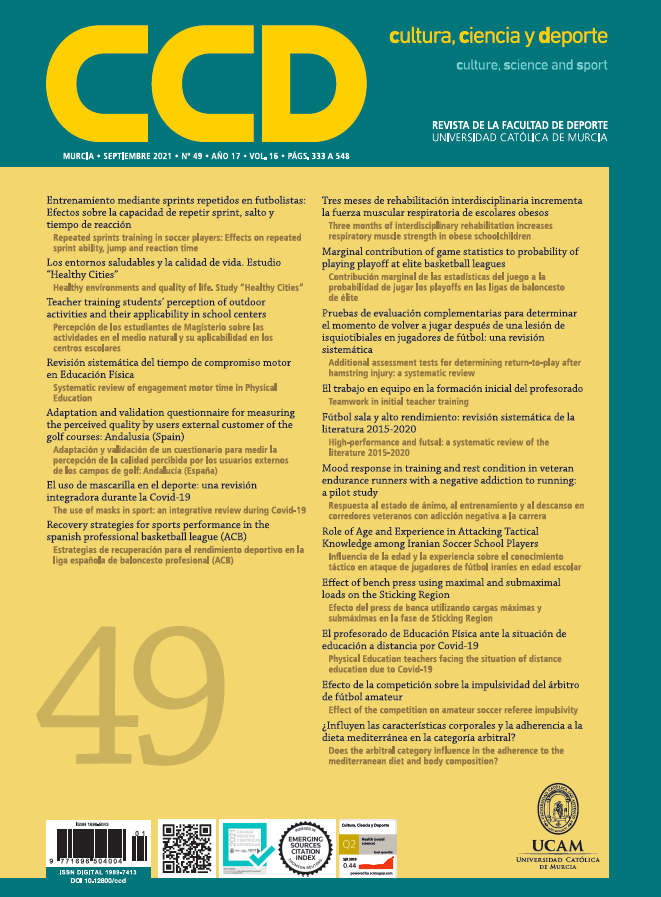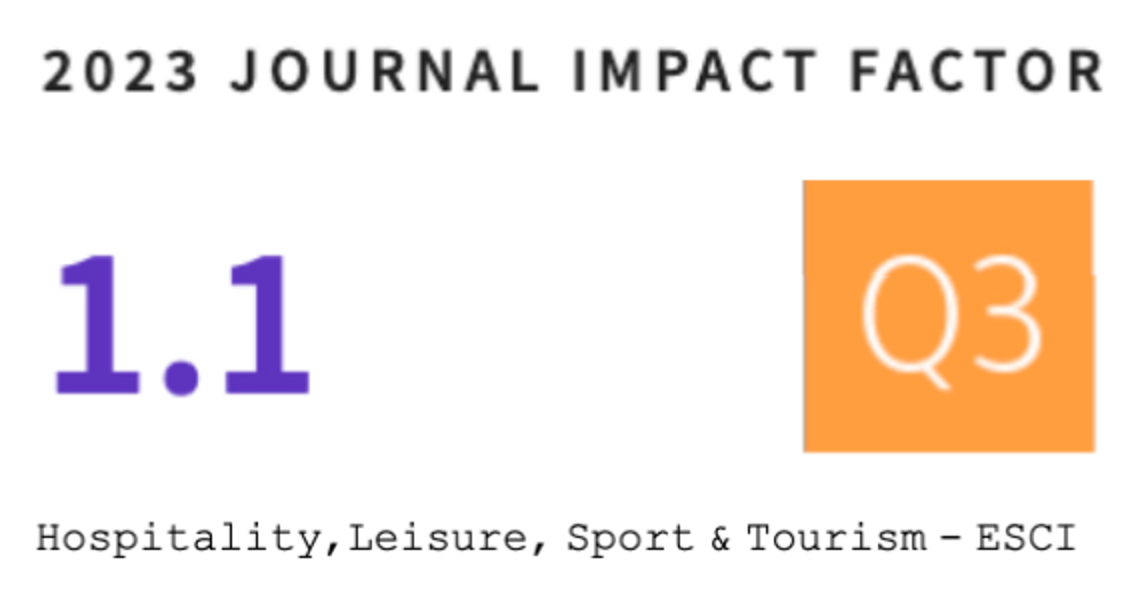Additional assessment tests for determining return-to-play after hamstring injury: a systematic review
DOI:
https://doi.org/10.12800/ccd.v16i49.1471Keywords:
isquiotibiales, lesión, volver a jugar, fútbolAbstract
Clinical examination is the main test to determine the moment in which soccer player can return to play after a hamstring injury, but other complementary measures are necessary to determine this moment without risk of re-injury. The aim of this systematic review was to analyze additional assessment tests to the clinical examination to determine the moment in which the soccer player can return to play after hamstring injury. A systematic literature review of databases PubMed, SPORTSDiscus, Web of Science, Scopus and PEDro was conducted using the following terms: “hamstring injury”, “return to play”, “return to sport”, “soccer”, and “football”. The additional assessment tests used by the studies to determine when a player can start playing again after hamstring injury were: magnetic resonance imaging (MRI) (n = 4), ultrasography (n = 1), Aksling H-test (n = 1), isokinetic test (n = 1) and sprint performance (n = 3). MRI seems to be a useful tool to predict return to play after hamstring injury. A strength deficit of >10% between both legs is associated with an increased risk of re-injury. Evaluation of mechanical properties during sprint running and the Aksling H-test have shown to be useful complementary tests to determine return to play. Biceps femoris has a high re-injury rate. More research is needed to establish objective criteria to make the decision about return to play after hamstring injury in soccer players.
References
Arnason, A., Sigurdsson, S. B., Gudmundsson, A., Holme, I., Engebretsen, L., & Bahr, R. (2004). Risk factors for injuries in football. The American Journal of Sports Medicine, 32, 5S-16S. doi:10.1177/0363546503258912
Askling, C. M., Nilsson, J., & Thorstensson, A. (2010). A new hamstring test to complement the common clinical examination before return to sport after injury. Knee Surgery, Sports Traumatology, Arthroscopy, 18, 1798-1803. doi:10.1007/s00167-010-1265-3
Askling, C. M., Tengvar, M., & Thorstensson, A. (2013). Acute hamstring injuries in Swedish elite football: a prospective randomised controlled clinical trial comparing two rehabilitation protocols. British Journal of Sports Medicine, 47, 953-959. doi:10.1136/bjsports-2013-092165
Bjørneboe, J., Bahr, R., & Andersen, T. E. (2014). Gradual increase in the risk of match injury in Norwegian male professional football: a 6-year prospective study. Scandinavian Journal of Medicine & Science in Sports, 24(1), 189-196. doi:10.1111/j.1600-0838.2012.01476.x
Chu, S. K., & Rho, M. E. (2016). Hamstring Injuries in the Athlete: Diagnosis, Treatment, and Return to Play. Current Sports Medicine Reports, 15(3), 184-190. doi:10.1249/JSR.0000000000000264
Chumanov, E. S., Heiderscheit, B. C., & Thelen, D. G. (2007). The effect of speed and influence of individual muscles on hamstring mechanics during the swing phase of sprinting. Journal of Biomechanics, 40, 3555-3562. doi:10.1016/j.jbiomech.2007.05.026
Cohen, S. B., Towers, J. D., Zoga, A., Irrgang, J. J., Makda, J., Deluca, P. F., & Bradley, J. P. (2011). Hamstring injuries in professional football players: magnetic resonance imaging correlation with return to play. Sports Health, 3(5), 423-430. doi:0.1177/1941738111403107
Connell, D. A., Schneider-Kolsky, M. E., Hoving, J. L., Malara, F., Buchbinder, R., Koulouris, G., Burke, F., & Bass, C. (2004). Longitudinal study comparing sonographic and MRI assessments of acute and healing hamstring injuries. AJR. American journal of roentgenology, 183(4), 975-984. doi:10.2214/ajr.183.4.1830975
Creighton, D. W., Shrier, I., Shultz, R., Meeuwisse, W. H., & Matheson, G. O. (2010). Return-to-play in sport: a decision-based model. Clinical Journal of Sport Medicine, 20, 379-985. doi:10.1097/JSM.0b013e3181f3c0fe
Croisier, J. L., Ganteaume, S., Binet, J., Genty, M., & Ferret, J. M. (2008). Strength imbalances and prevention of hamstring injury in professional soccer players: a prospective study. The American Journal of Sports Medicine, 36(8), 1469-1475. doi:10.1177/0363546508316764
de Hoyo, M., Naranjo-Orellana, J., Carrascoa, L., Sañudoa, B., Jiménez-Barrocab, J. J., & Domínguez-Cobo, S. (2013). Revisión sobre la lesión de la musculatura isquiotibial en el deporte: factores de riesgo y estrategias para su prevención. Revista Andaluza de Medicina del Deporte, 6(1), 28-35. doi:10.1016/S1888-7546(13)70032-7
Dellal, A., Lago-Penas, C., & Rey, E. (2015). The effects of a congested fixture period on physical performance, technical activity and injury rate during matches in a professional soccer team. British Journal of Sports Medicine, 49(6), 390-394. doi:10.1136/bjsports-2012-091290
Delvaux, F., Rochcongar, P., Bruyère, O., Bourlet, G., Daniel, C., Diverse, P., Reginster, J., & Croisier, J. (2013). Return-to-play criteria after hamstring injury: actual medicine practice in professional soccer teams. British Journal of Sports Medicine, 10(47), e3.53-e3. doi:10.1136/bjsports-2013-092558.57
Downs, S. H., & Black, N. (1998). The feasibility of creating a checklist for the assessment of the methodological quality both of randomised and non-randomised studies of health care interventions. Journal of Epidemiology and Community Health, 52(6), 377-384. doi:10.1136/jech.52.6.377
Dunlop, G., Ardern, C. L., Andersen, T. E., Lewin, C., Dupont, G., Ashworth, B., O'Driscoll, G., Rolls, A., Brown, S., & McCall, A. (2020). Return-to-play practices following hamstring injury: A Worldwide Survey of 131 Premier League Football Teams. Sports Medicine, 50(4), 829-840. doi:10.1007/s40279-019-01199-2
Ekstrand, J., Hägglund, M., & Waldén, M. (2011a). Epidemiology of muscle injuries in professional football (soccer). The American Journal of Sports Medicine, 39, 1226-1232. doi:10.1177/0363546510395879
Ekstrand, J., Hägglund, M., & Walden, M. (2011b). Injury incidence and injury patterns in professional football: the UEFA injury study. British Journal of Sports Medicine, 45, 553-558. doi:10.1136/bjsm.2009.060582
Ekstrand, J., Healy, J. C., Waldén, M., Lee, J. C., English, B., & Hägglund, M. (2012). Hamstring muscle injuries in professional football: the correlation of MRI findings with return to play. British Journal of Sports Medicine, 46(2), 112-117. doi:10.1136/bjsports-2011-090155
Ekstrand, J., Lee, J. C., & Healy, J. C. (2016b). MRI findings and return to play in football: a prospective analysis of 255 hamstring injuries in the UEFA Elite Club Injury Study. British Journal of Sports Medicine, 50(12), 738-743. doi:10.1136/bjsports-2016-095974
Ekstrand, J., Waldén, M., & Hägglund, M. (2016a). Hamstring injuries have increased by 4% annually in men’s professional football, since 2001: a 13-year longitudinal analysis of the UEFA Elite Club injury study. British Journal of Sports Medicine, 50, 731-737. doi:10.1136/bjsports-2015-095359
FIFA. (2007). Gran censo 2006. FIFA magazine, 7, 12-14.
Freckleton, G., & Pizzari, T. (2013). Risk factors for hamstring muscle strain injury in sport: a systematic review and meta-analysis. British Journal of Sports Medicine, 47, 351-358. doi:10.1136/bjsports-2011-090664
Fuller, C. W., Ekstrand, J., Junge, A., Andersen, T. E., Bahr, R., Dvorak, J., Hägglund, M., McCrory, P., & Meeuwisse, W. H. (2006). Consensus statement on injury definitions and data collection procedures in studies of football (soccer) injuries. British Journal of Sports Medicine, 40(3), 193-201. doi:10.1136/bjsm.2005.025270
Hägglund, M., Waldén, M., & Ekstrand, J. (2006). Previous injury as a risk factor for injury in elite football: a prospective study over two consecutive seasons. British Journal of Sports Medicine, 40, 767-772. doi:10.1136/bjsm.2006.026609
Hägglund, M., Waldén, M., & Ekstrand, J. (2013). Risk Factors for Lower Extremity Muscle Injury in Professional Soccer: The UEFA Injury Study. The American Journal of Sports Medicine, 41, 327-335. doi:10.1177/0363546512470634
Hallén, A., & Ekstrand, J. (2014). Return to play following muscle injuries in professional footballers. Journal of Sports Sciences, 32(13), 1229-1236. doi:10.1080/02640414.2014.905695
Hamilton, B., Wangensteen, A., Whiteley, R., Almusa, E., Geertsema, L., Targett, S., & Tol, J. L. (2018). Cohen's MRI scoring system has limited value in predicting return to play. Knee Surgery, Sports Traumatology, Arthroscopy, 26(4), 1288-1294. doi:10.1007/s00167-016-4403-8
Hickey, J. T., Timmins, R. G., Maniar, N., Williams, M. D., & Opar, D. A. (2017). Criteria for Progressing Rehabilitation and Determining Return-to-Play Clearance Following Hamstring Strain Injury: A Systematic Review. Sports Medicine, 47(7), 1375-1387. doi:10.1007/s40279-016-0667-x
Koulouris, G., Connell, D. A., Brukner, P., & Schneider-Kolsky, M. (2007). Magnetic resonance imaging parameters for assessing risk of recurrent hamstring injuries in elite athletes. The American Journal of Sports Medicine, 35, 1500–1506. doi:10.1177/0363546507301258
Liberati, A., Altman, D. G., Tetzlaff, J., Mulrow, C., Gøtzsche, P. C., Ioannidis, J. P., Clarke, M., Devereaux, P. J., Kleijnen, J., & Moher, D. (2009). The PRISMA statement for reporting systematic reviews and meta-analyses of studies that evaluate health care interventions: explanation and elaboration. Journal of Clinical Epidemiology, 62(10), 1-34. doi:10.1371/journal.pmed.1000100
Mendiguchia, J., Edouard, P., Samozino, P., Brughelli, M., Cross, M., Ross, A., Gill, N., & Morin, J. B. (2016). Field monitoring of sprinting power-force-velocity profile before, during and after hamstring injury: two case reports. Journal of Sports Sciences, 34, 535-541. doi:10.1080/02640414.2015.1122207
Mendiguchia, J., Samonzino, P., Martinez-Ruiz, E., Brughelli, M., Schmikli, M., Morin, J. B., & Mendez-Villanueva, A. (2014). Progression on mechanical properties during on the field sprint running and returning to sports from a hamstring muscle injury in soccer players. International Journal of Sports Medicine, 35(8), 690-695. doi:10.1055/s-0033-1363192
Noya, J., Gómez-Carmona, P. M., Gracia-Marco, L., Moliner-Urdiales, D., & Sillero-Quintana, M. (2014). Epidemiology of injuries in First Division Spanish football. Journal of Sports Sciences, 32(13), 1263-1270. doi:10.1080/02640414.2014.884720
Orchard, J. W. (2001). Intrinsic and extrinsic risk factors for muscle strains in Australian football. The American Journal of Sports Medicine, 29, 300-303. doi:10.1177/03635465010290030801
Petersen, J., Thorborg, K., Nielsen, M. B., Skjødt, T., Bolvig, L., Bang, N., & Hölmich, P. (2014). The diagnostic and prognostic value of ultrasonography in soccer players with acute hamstring injuries. The American Journal of Sports Medicine, 42(2), 399-404. doi:10.1177/0363546513512779
Pfirrmann, D., Herbst, M., Ingelfinger, P., Simon, P., & Tug, S. (2016). Analysis of Injury Incidences in Male Professional Adult and Elite Youth Soccer Players: A Systematic Review. Journal of Athletic Training, 51(5), 410-424. doi:10.4085/1062-6050-51.6.03
Sanfilippo, J. L., Silder, A., Sherry, M. A., Tuite, M. J., & Heiderscheit, B. C. (2013). Hamstring strength and morphology progression after return to sport from injury. Medicine & Science in Sports & Exercise, 45, 448-454. doi:10.1249/MSS.0b013e3182776eff
Schneider-Kolsky, M. E., Hoving, J. L., Warren, P., Connell, D. A. (2006). A comparison between clinical assessment and magnetic resonance imaging of acute hamstring injuries. The American Journal of Sports Medicine, 34(6), 1008-1015. doi:10.1177/0363546505283835
Servicios médicos FC Barcelona. (2009). Guía de Práctica Clínica de las lesiones musculares. Epidemiología, diagnóstico, tratamiento y prevención. Apunts. Educación Física y Deportes, 44(164), 179-203.
Setuain, I., Lecumberri, P., & Izquierdo, M. (2017). Sprint mechanics return to competition follow-up after hamstring injury on a professional soccer player: A case study with an inertial sensor unit based methodological approach. Journal of Biomechanics, 63, 186-191. doi:10.1016/j.jbiomech.2017.08.010
Thelen, D. G., Chumanov, E. S., Hoerth, D. M., Best, T. M., Swanson, S. C., Li, L., Young, M., & Heiderscheit, B. C. (2005). Hamstring muscle kinematics during treadmill sprinting. Medicine & Science in Sports & Exercise, 37(1), 108-114. doi:10.1249/01.mss.0000150078.79120.c8
Tol, J. L., Hamilton, B., Eirale, C., Muxart, P., Jacobsen, P., & Whiteley, R. (2014). At return to play following hamstring injury the majority of professional football players have residual isokinetic deficits. British Journal of Sports Medicine, 48(18), 1364-1369. doi:10.1136/bjsports-2013-093016
van der Horst, N., Backx, F., Goedhart, E. A., Huisstede, B. M., & HIPS-Delphi Group. (2017). Return to play after hamstring injuries in football (soccer): a worldwide Delphi procedure regarding definition, medical criteria and decision-making. British Journal of Sports Medicine, 51(22), 1583-1591. doi:10.1136/bjsports-2016-097206
van der Horst, N., van de Hoef, S., Reurink, G., Huisstede, B., & Backx, F. (2016). Return to play after hamstring injuries: A qualitative systematic review of definitions and criteria. Sports Medicine, 46(6), 899-912. doi:10.1007/s40279-015-0468-7
van Doormaal, M. C., van der Horst, N., Backx, F. J., Smits, D. W., & Huisstede, B. M. (2017). No relationship between hamstring flexibility and hamstring injuries in male amateur soccer players. The American Journal of Sports Medicine, 45, 121-126. doi:10.1177/0363546516664162
van Dyk, N., Farooq, A., Bahr, R., & Witvrouw, E. (2018). Hamstring and Ankle Flexibility Deficits Are Weak Risk Factors for Hamstring Injury in Professional Soccer Players: A Prospective Cohort Study of 438 Players Including 78 Injuries. The American Journal of Sports Medicine, 46(9), 2203-2210. doi:10.1177/0363546518773057
Wangensteen, A., Almusa, E., Boukarroum, S., Farooq, A., Hamilton, B., Whiteley, R., Bahr, R., & Tol, J. L. (2015). MRI does not add value over and above patient history and clinical examination in predicting time to return to sport after acute hamstring injuries: a prospective cohort of 180 male athletes. British Journal of Sports Medicine, 49, 1579-1587. doi:10.1136/bjsports-2015-094892
Witvrouw, E., Danneels, L., Asselman, P., D'Have, T., & Cambier, D. (2003). Muscle flexibility as a risk factor for developing muscle injuries in male professional soccer players. A prospective study. The American Journal of Sports Medicine, 31(1), 41-46. doi:10.1177/03635465030310011801
Woods, C., Hawkins, R., Maltby, S., Hulse, M., Thomas, A., & Hodson, A. (2004). The Football Association Medical Research Programme: an audit of injuries in professional football - analysis of hamstring injuries. British Journal of Sports Medicine, 38, 36-41. doi:10.1136/bjsm.2002.002352
Downloads
Published
How to Cite
Issue
Section
License
Copyright (c) 2021 Creative Commons Attribution License

This work is licensed under a Creative Commons Attribution-NonCommercial-ShareAlike 4.0 International License.
The authors who publish in this journal agree with the following terms:
- The authors retain the copyright and guarantee the journal the right to be the first publication of the work as well as licensed under a Creative Commons Attribution License that allows others to share the work with recognition of the authorship of the work and the initial publication in this journal.
















